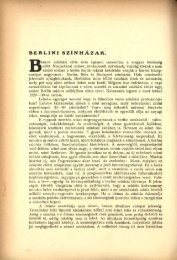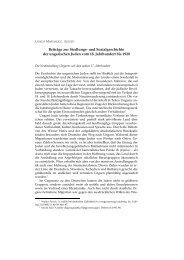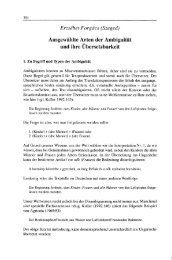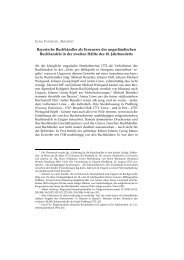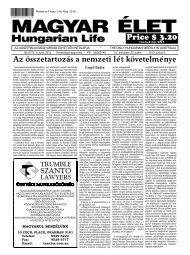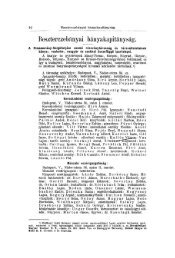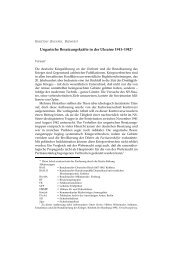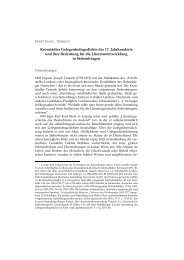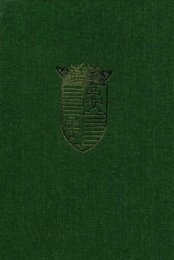Aquincumi füzetek 17. (2011.) - EPA
Aquincumi füzetek 17. (2011.) - EPA
Aquincumi füzetek 17. (2011.) - EPA
You also want an ePaper? Increase the reach of your titles
YUMPU automatically turns print PDFs into web optimized ePapers that Google loves.
Újabb eredmények a<br />
Belvárosi Plébániatemplom<br />
és a Március 15. téri erőd<br />
kutatásában<br />
(Budapest, V. ker., Március 15. tér,<br />
Hrsz.: 24314)<br />
A Budapest Szíve Program keretében a<br />
Főváros 2010-ben megkezdte a belvárosi<br />
Március 15. tér felszíni rendezését. A<br />
kivitelezői munkálatok során több régi<br />
közművet kicseréltek, illetve új közműnyomvonalakat<br />
létesítettek, védőépülettel<br />
látták el a késő római erőd korábban szabadon<br />
álló oldaltornyát, nagyobb földmunkával<br />
járó tereprendezési munkát végeztek<br />
a plébániatemplom mellett és a műemléki<br />
romterület térségében. Ennélfogva több<br />
kisebb, egymástól térben elkülönülő felületen<br />
vált szükségessé régészeti szakfelügyelet,<br />
illetve néhol megelőző feltárás.<br />
A régészeti munkák 2010. augusztus 18tól<br />
<strong>2011.</strong> február 22-ig tartottak, amelyek<br />
során római kori, középkori és kora újkori<br />
leletek, objektumok kerültek elő.<br />
Római kor<br />
Budapest római kori emlékeinek egyik<br />
kiemelkedő fontosságú építménye a Március<br />
15. téri késő római erőd (1. kép),<br />
korábbi, általánosan elfogadott nevén<br />
Contra Aquincum (az erőd nevéhez:<br />
MRÁV 1992–1995). A limesmenti segédcsapat-táborokhoz<br />
mérten viszonylag<br />
kisméretű, romboid formájú erőd kiterjedése<br />
csupán 86×84 m volt. Sarkait legyező<br />
alakú tornyokkal, oldalait 2-2 U alakú,<br />
falsíkból kiugró oldaltoronnyal látták el.<br />
Falait – amelybe másodlagosan sok ko-<br />
112<br />
New results from the<br />
investigations of the inner<br />
City Parish Church and the<br />
late Roman fort on Március<br />
15 Square<br />
(Budapest V, 15 March Square,<br />
Lrn.: 24314)<br />
Within the framework of the Budapest’s<br />
‘Heart Project’, the Capital City started<br />
the re-arrangement of the surface of Március<br />
15 square in the inner city in 2010.<br />
The old public utilities were exchanged<br />
and new paths identified for public utilities<br />
in the course of the construction<br />
work. A protective building was raised over<br />
the side tower of the late Roman fort that<br />
formerly stood out in the open. At the<br />
same time, a large-scale landscaping with<br />
significant earth moving work was carried<br />
out beside the parish church and over the<br />
territory of the Roman ruins. Thus, archaeological<br />
supervision was necessary at<br />
a number of separate, small territories and<br />
an investment-driven excavation had to be<br />
conducted in a few spots.<br />
The archaeological work was carried out<br />
between August 18, 2010 and February<br />
22, <strong>2011.</strong> Roman Period, medieval and<br />
modern period finds and features were<br />
uncovered.<br />
Roman Period<br />
The late Roman fort on Március 15<br />
Square (Fig. 1), formerly called Contra<br />
Aquincum (for the name of the fort see<br />
MRÁV 1992-1995), is an important Roman<br />
Period monument in Budapest. Compared<br />
to the auxiliary forts on the limes, it<br />
was relatively small with a rhomboid shape
DUNA<br />
Késő római erőd<br />
Late Roman fortress<br />
Belvárosi Plébániatemplom<br />
Inner city Parish church<br />
A feltárt és bemutatott<br />
északi oldaltorony<br />
The excavated and visible<br />
northern wall tower<br />
Erzsébet híd<br />
rábbi római kőemléket építettek – imponáló,<br />
3,4 méter vastagságban húzták fel<br />
(az erődről összefoglalóan: NAGY 1946;<br />
VISY 2000, 58.; NÉMETH 2003). A késő<br />
rómi erőd megépítésére valamikor a Kr. u.<br />
330-as, 340-es években került sor (TÓTH<br />
2009, 151), amikor a limes mentén és a<br />
pannoniai tartományok belsejében is nagyobb,<br />
központilag irányított erődítési<br />
program indul el.<br />
Az erőd területén az első kiterjedtebb<br />
régészeti feltárásra 1932-ben került sor,<br />
amikor a tér (korabeli nevén Eskü tér)<br />
északi részén álló régi piarista rendházat<br />
lebontották. Az ásatást vezető Nagy Lajos<br />
kutatóárkos módszerrel feltárta az északi<br />
erődfal hosszabb szakaszát a nyugati, U<br />
alakú oldaltoronnyal együtt (NAGY 1946,<br />
37–43). Az erőd északkeleti saroktornyának<br />
kisebb részlete is előkerült, azonban<br />
statikai okok miatt már nem tudta kibontani.<br />
Nem mellékes információ az erőd be-<br />
1. sz. munkahely<br />
Location 1<br />
1. kép: A Március 15. téri késő római erőd alaprajza<br />
Fig. 1: Ground plan of the late Roman fort on Március 15 Square<br />
2. sz. munkahely<br />
Location 2<br />
0 100m<br />
measuring 86×84 m. Fan-shaped towers<br />
were built on the corners and two Ushaped<br />
towers jutted out from the plane<br />
of each wall. The walls, which secondarily<br />
incorporated many earlier Roman stone<br />
monuments had an imposing thickness of<br />
3.4 m (for a summary of the fort: NAGY<br />
1946; VISY 2000, 58.; NÉMETH 2003).<br />
The later Roman fort was built sometime<br />
in the AD 330s or 340s (TÓTH 2009,<br />
151) when a large, centrally directed fortification<br />
program started along the limes<br />
within the Pannonian provinces.<br />
The first large archaeological excavation<br />
was conducted on the territory of the fort<br />
in 1932 when the old Piarist monastery<br />
was pulled down in the northern part of<br />
the square (called Eskü Square at that<br />
time). Lajos Nagy directed the excavation.<br />
He unearthed a long stretch of the northern<br />
wall of the fortification along with<br />
the western U-shaped wall tower in the<br />
113
építettségével kapcsolatban, hogy a tábor<br />
belsejében húzott három kutatóárok közül<br />
egyikben sem sikerült római építményeket<br />
kimutatni, csupán Árpád-kori csontvázas<br />
sírok és agyagba rakott fal maradványai<br />
kerültek elő (a sírokról bővebben lásd lentebb<br />
a középkori fejezetet).<br />
Felismerve az előkerült romok jelentőségét,<br />
az erőd északi falmaradványai fölött,<br />
Möller István tervei alapján, kisebb<br />
földalatti múzeumépületet alakítottak ki.<br />
1944 nyarán egy tereprendezéshez<br />
kapcsolódóan újabb feltárást rendelt el<br />
a Fővárosi Régészeti és Ásatási Intézet,<br />
ezúttal a tér déli traktusában, a Belvárosi<br />
Plébániatemplom déli oldalán. A Bertalan<br />
Vilmos vezette ásatás számos új információval<br />
szolgált – sok egyéb mellett – a római<br />
erőd kiterjedése és építéstörténetére<br />
vonatkozóan is (BERTALAN 1945). Ekkor<br />
sikerült feltárni az erőd délkeleti saroktornyát<br />
és az egyik déli oldaltorony kisebb<br />
részletét. Az oldaltorony alatt egy korábbi<br />
római kőerőd falának nyomait vélte felfedezni<br />
az ásató. Az oldaltoronytól nyugatra<br />
pillérszerűen kiugró, elbontott római falak<br />
nyomaira bukkantak, amelyeket egy korábbi<br />
római tábor kapubejáratának véltek.<br />
A késő római erőd építéstechnikai megoldásaihoz<br />
a saroktorony szolgált hasznos<br />
információkkal. Ennek alapozásában<br />
ugyanis szabályos lyukak sorát figyelték<br />
meg, amelyek valószínűleg a falak merevítésére<br />
szolgáló függőleges gerendák helyei<br />
voltak.<br />
1961-ben kezdődött meg az Erzsébet<br />
híd több évig tartó felújítása. E munkálatokhoz<br />
kapcsolódóan korszerűsítették,<br />
átépítették a Március 15. teret, egyúttal<br />
lebontották az erőd északi falának maradványai<br />
fölé felhúzott korábbi múzeumépületet<br />
is. Az új műemléki koncepciónak<br />
megfelelően a maradványokat egy korlá-<br />
114<br />
trenches he opened (NAGY 1946, 37–43).<br />
A small part of the northeastern corner<br />
tower was also found but could not be unearthed<br />
due to static reasons it. Another<br />
important piece of information regarding<br />
the inner arrangement of the fort was that<br />
none of the three trenches excavated inside<br />
the fort contained Roman buildings. Only<br />
Árpád Period inhumation burials and the<br />
remains of a wall laid in clay were identified<br />
(on the graves see the later chapter on<br />
medieval finds). The importance of the<br />
ruins brought to light was recognized and<br />
a small subterranean museum building<br />
was built over the remains of the northern<br />
wall of the fort based on designs by István<br />
Möller.<br />
In the summer of 1944, the Archaeological<br />
and Excavation Institute of Budapest<br />
ordered another excavation in<br />
connection with landscaping work: this<br />
time in the southern part of the square<br />
on the southern side of the Inner City<br />
Parish Church. Vilmos Bertalan directed<br />
the excavation which provided many new<br />
pieces of information on the extent and<br />
the construction history of the Roman<br />
fort (BERTALAN 1945). He unearthed<br />
the southeastern corner tower of the fort<br />
and a smaller section of one of the southern<br />
wall towers. Under the wall tower he<br />
identified traces of a wall from an earlier<br />
Roman stone fortification. West of the<br />
wall tower, traces of removed Roman walls<br />
were uncovered that jutted out from the<br />
wall like pillars. They were interpreted as<br />
being part of the gate of an earlier Roman<br />
fort. The corner tower yielded further information<br />
on the technological solutions<br />
utilized in the construction of the late Roman<br />
fort. Rows of regular holes were observed<br />
in the foundation, probably for the<br />
vertical beams used to brace the walls.
2. kép: Az 1. munkaterület<br />
római kori objektumainak<br />
foltjai<br />
Fig. 2: Discolorations<br />
from Roman features in<br />
location 1<br />
tozottabb kiterjedésű szabadtéri romkert<br />
kialakításával mutatták be, ahol az egyik<br />
északi oldaltornyot az erődfal egy kisebb<br />
szakaszával együtt konzerválva és részben<br />
felfalazva, míg a másik északi oldaltornyot<br />
a térbetontól elütő színű vörös, didaktikus<br />
sávval jelölték. A régészeti munkákat ekkor<br />
Nagy Tibor vezette.<br />
Legutóbb 2006-ban (BESZÉDES–<br />
ZÁDOR 2007, 266) és 2007-ben<br />
(BESZÉDES–PAPP–ZÁDOR 2008) folytak<br />
kisebb ásatások az erőd északkeleti sarkának<br />
közvetlen közelében, de az erődön<br />
kívül, a Piarista Gimnázium (egykor: EL-<br />
TE BTK ’A’ épület) udvarán. A feltárások<br />
során tisztázódott, hogy a korábbi építkezéseknél<br />
részleteiben már többször előkerült<br />
fürdőépület nem római kori, hanem<br />
a török korból való (BESZÉDES–PAPP–<br />
ZÁDOR 2008, 168; korábbi irodalom:<br />
NAGY 1946, 8–10). Ugyancsak fontos új<br />
adat volt, hogy előkerült a késő római erőd<br />
fossájának (amelyről korábban semmit<br />
nem tudtunk) egy kisebb szakasza, az árok<br />
fordulásával együtt (BESZÉDES–PAPP–<br />
ZÁDOR 2008, 165).<br />
The reconstruction of Elisabeth bridge<br />
started in 1961 and lasted for several years.<br />
In connection to it, Március 15 Square<br />
was modernized and reconstructed which<br />
meant the demolition of the earlier museum<br />
building raised over the remains of<br />
the northern wall of the fort. According to<br />
the new monument concept, the remains<br />
were exhibited in a smaller open-air ruins<br />
area where one of the northern wall towers<br />
and a short stretch of the wall were<br />
conserved and partly heightened, while<br />
the other northern wall tower was marked<br />
with a red, didactic band and stood out<br />
against the concrete of the square. Tibor<br />
Nagy directed the archaeological work.<br />
Recently, small excavations were conducted<br />
close to the northeastern corner<br />
of the fort outside the fort in the yard<br />
of the Piarist Secondary School (formerly<br />
building “A” of the ELTE BTK) in<br />
2006 (BESZÉDES–ZÁDOR 2007, 266)<br />
and 2007 (BESZÉDES–PAPP–ZÁDOR<br />
2008). The excavations clarified that the<br />
bath, parts of which had already been<br />
identified a few times during construc-<br />
115
A Március 15. tér 2010-ben végzett átépítési<br />
munkálatainak folyamatos régészeti<br />
szakfelügyelete során két olyan munkaterület<br />
alakult ki, ahol római kori rétegeket<br />
érintettek a kivitelezői munkák (1. kép).<br />
Az 1. számú munkaterületünk a római<br />
erőd helyreállított oldaltornyának keleti<br />
oldalán, az erődön kívül húzódott. Itt<br />
a készülő műemléki védőépület falának<br />
alapozási munkálatai egy korábban még<br />
bolygatatlan felületet érintettek, ezért vált<br />
szükségessé mintegy 40 m²-en a megelőző<br />
feltárás. A felszíntől 40 cm mélységben az<br />
első piarista rendház 18. századi alapfalainak<br />
visszabontott maradványa jelentkezett.<br />
Lejjebb, 80 cm mélységben a sárga<br />
altalajba mélyítve római kori objektumok<br />
kerültek elő: egy cölöplyuk és három kerek<br />
formájú, ívelt falú, vízszintes aljú gödör,<br />
amelyeket részben a piarista rendház fala,<br />
részben újkori építmények vágtak (2. és 3.<br />
kép).<br />
Ezek betöltésében szembetűnően<br />
sok volt a tegulatöredék, bélyeges téglát<br />
azonban nem találtunk. A kevés kerámiaanyagot<br />
főként a helyi készítésű<br />
116<br />
tion work, Turkish period dated to this<br />
later period and not the Roman times<br />
(BESZÉDES–PAPP–ZÁDOR 2008, 168;<br />
earlier literature: NAGY 1946, 8–10).<br />
It was, however, important that a short<br />
stretch of the fossa surrounding the late<br />
Roman fort was also found (of which we<br />
had not known) together with the bend in<br />
the ditch (BESZÉDES–PAPP–ZÁDOR<br />
2008, 165).<br />
During the continuous archaeological<br />
supervision of the reconstruction work,<br />
two locations were identified where Roman<br />
period layers were impacted at Március<br />
15 Square in 2010 (Fig. 1).<br />
Location 1 was on the eastern side of<br />
the reconstructed wall tower of the Roman<br />
fort, outside the fort. The foundation<br />
of the protective building destined<br />
to be raised here would be dug into yet<br />
undisturbed surfaces so an investmentled<br />
excavation had to be conducted over<br />
an area about 40 m 2 . The removed 18th<br />
century foundation walls of the first Piarist<br />
monastery appeared 40 cm under the<br />
surface. At a depth of 80 cm, Roman peri-<br />
3. kép: Az 1.munkaterület<br />
római kori objektumai<br />
kibontott állapotban<br />
Fig. 3: Cleaned Roman<br />
features in location 1
4. kép: Másodlagosan beépített<br />
profilált tagozat töredéke a késő római<br />
erődfalban<br />
Fig. 4: Fragment of a secondarily<br />
built-in profiled architectural element<br />
in the wall of the late Roman fort<br />
szürke házikerámia tette ki, de előkerült<br />
S profilú edénytöredék is. Kr. u. 4. századra<br />
keltezhető leletanyagnak nem volt<br />
nyoma. Kiemelendő az SE-110-es objektum,<br />
amelynek betöltésében a nagyszámú<br />
tegula töredéken kívül, egy kopott 3. századi(?)<br />
érem és terrazzodarabkák kerültek<br />
elő.<br />
A feltárt objektumok nem tartozhattak<br />
a késő római erődhöz, annak építési idejénél<br />
korábbiak voltak. Arra a kérdésre, hogy<br />
egy korábbi táborperiódushoz, vagy egy<br />
telephez tartoztak volna, nem adható egyértelmű<br />
válasz.<br />
A 2. számú munkaterületünket egy átlagosan<br />
3 méter mélyen futó régi csatorna<br />
nyomvonala jelentette, amely keresztülfutott<br />
az erőd területén. A közműcsere főként<br />
a régi nyomvonalon haladt, de egyes<br />
szakaszokon ennek korrekciójára, kisebb<br />
módosítására kényszerült a kivitelező. A<br />
csatornaárok erőd belsejében lévő szakaszain<br />
római kőobjektumnak nem találtuk<br />
nyomát, csupán rétegeket és leletanyagot<br />
tudtunk a korszakhoz kötni. Egy, a felszíntől<br />
3,4 méter mélységben előkerült, há-<br />
od features were found dug into the yellow<br />
subsoil: a posthole and three round pits<br />
with curved walls, intersected both by the<br />
wall of the Piarist monastery and modern<br />
constructions (Figs 2, 3).<br />
Their fills contained many tegula fragments<br />
but no stamped bricks. Locally<br />
made grey household pottery dominated<br />
the few shards but we also found “S”-profiled<br />
fragments. There was no sign of finds<br />
from the 4th century. Feature no. SE-110<br />
must separately be mentioned since its fill<br />
contained a worn coin from the 3rd century<br />
(?) and terrazzo fragments in addition<br />
to many tegula fragments. The excavated<br />
features could not have belonged to the<br />
late Roman fort because they were older.<br />
It is unclear if they belonged to an earlier<br />
fort period or a settlement.<br />
Location 2 followed the path of a modern<br />
sewer line running at an average depth<br />
of 3 m which crossed the territory of the<br />
fort. The new public utilities generally ran<br />
in the paths of the old ones but in a few<br />
places the paths had to be modified. No<br />
trace of stone features was found in the<br />
117
ton, nyújtott helyzetben, fejjel nyugat felé<br />
néző emberi csontváz kormeghatározása<br />
bizonytalan. Nagy valószínűséggel Árpádkorinak<br />
tarthatjuk, mivel ugyanebből a<br />
mélységből azonos tájolással, több Árpádkori<br />
sír is előkerült Nagy Lajos 1932-ben<br />
folytatott feltárása során.<br />
A 2. számú munkahelyen folytatott<br />
megfigyelések közül a legfontosabb eredményt<br />
a késő római erőd déli falának előkerülése<br />
(hitelesítése) jelentette, amelyet<br />
a régi csatorna-közműárok csaknem merőlegesen<br />
átvágott. A mintegy 3,6 méter<br />
vastag erődfal alapozási részén másodlagosan<br />
beépített profilált párkányzatot találtunk<br />
(4. kép), amelyet kiemelése után<br />
az <strong>Aquincumi</strong> Múzeumba szállítottunk<br />
(ltsz.: <strong>2011.</strong>2.1.). (B. J.)<br />
Középkor<br />
A tér rekonstrukciójához kapcsolódóan<br />
a Belvárosi Főplébánia-templom közvetlen<br />
környékét is érintette régészeti szakfelügyelet<br />
és megelőző feltárás. Az épület<br />
kutatása még nem fejeződött be, a templom<br />
körüli temető részleteinek feltárása<br />
azonban lezárult. Itt, az északi és a déli oldalon,<br />
az új nyomvonalra kerülő közművek<br />
árkában tudtunk dolgozni.<br />
Amint azt már fentebb is említettük<br />
sírokat először 1932-ben tártak fel a templomtól<br />
északra (NAGY 1946, 44–45). Ezek<br />
a temetkezések a római tábor feltárására<br />
irányuló kutatás IV-VI. számú árkaiban<br />
kerültek elő. Az Árpád-kori sírok egy részét<br />
kővel és római téglákkal rakták körül,<br />
mellékletként néhány hajkarikát és<br />
egy 12. századi pénz találtak. A későbbi,<br />
magasabb szinten elhelyezkedő és változó<br />
tájolású sírokat a feltáró a 18. századra<br />
keltezte. A következő feltárás 1944-ben<br />
zajlott a templom déli oldalán (BERTA-<br />
LAN 1945), ekkor kutatóárkokat nyitottak<br />
118<br />
trench for the sewer inside the fort. Only<br />
the layers and finds could be associated<br />
with the period. The dating of an inhumation<br />
burial lying extended on its back<br />
with the head towards the west found at<br />
a depth of 3.4 m from the surface is uncertain.<br />
There were no grave goods next<br />
to the skeleton and we think that it came<br />
from the Árpád period. Lajos Nagy recovered<br />
several Árpád Period graves with the<br />
same orientation and at the same depth in<br />
1932.<br />
From the observations made at location<br />
2, the appearance (authentication) of the<br />
southern wall of the late Roman fort was<br />
the most significant. I had been cut nearly<br />
perpendicularly by the trench for the old<br />
sewer line. A secondarily built-in profiled<br />
cornice was found in the foundation of<br />
the nearly 3.6 m thick wall of the fort (Fig.<br />
4). It was lifted and transported to the<br />
Aquincum Museum (inv. no. <strong>2011.</strong>2.1).<br />
(J. B.)<br />
Middle Ages<br />
The archaeological supervision and the<br />
investment-led excavations connected<br />
with the reconstruction of the square also<br />
affected the direct vicinity of the Inner<br />
City Parish Church. The investigation of<br />
the building has not yet been completed<br />
but the excavation of parts of the churchyard<br />
has been completed. We worked in<br />
the trench for the new public utilities on<br />
the northern and the southern sides.<br />
As has already been mentioned, the<br />
first graves were uncovered north of the<br />
church in 1932 (NAGY 1946, 44–45).<br />
They were found in trenches IV-VI of the<br />
excavation of the Roman fort. A few of the<br />
Árpád Period graves were surrounded with<br />
stones and Roman bricks. Included among<br />
the grave goods were a few lockrings and a
a római tábor kiterjedésének tisztázására.<br />
A tanulmány részleteket nem közöl a középkori<br />
temetőről, annyi azonban a metszet-<br />
és alaprajzokból kiderül, hogy a sírréteg<br />
vastagsága néhol még a 2 métert is<br />
meghaladta, valamint hat réteget tudtak<br />
elkülöníteni. A temetkezések idejét az Árpád-kortól<br />
a 15. század végéig határozták<br />
meg.<br />
A római tábor északi falát bemutató<br />
műemléki helyreállítást megelőzően újabb<br />
területeket tártak fel a templomtól északra,<br />
ahol ugyancsak sírok láttak napvilágot<br />
(IRÁSNÉ 1976, 317). Az 1970-es években<br />
a közművesítéshez kapcsolódó leletmentések<br />
során szintén találtak temetkezéseket,<br />
emellett jellemző volt, hogy a földmunkák<br />
során nagy mennyiségben kerültek elő<br />
bolygatott embercsontok a felső rétegekből<br />
is (IRÁSNÉ 1976, 316–319). Általános<br />
megfigyelés volt az is, hogy a legkorábbi sírokat<br />
már a késő római planírozási rétegbe<br />
ásták.<br />
2002-ben a templomon belül, a sekrestye<br />
előterében végeztünk minden részletre<br />
kiterjedő feltárást (KOVÁCS–SZIRMAI<br />
2003). Itt a középkori téglapadló alatt<br />
(amelynek építése a 15. század közepére<br />
tehető) még a temető járószintjét is meg<br />
tudtuk figyelni. A mintegy 1 méter vastag<br />
rétegben, amelyben a melléklet nélküli<br />
temetkezések voltak, római kori és 11-13.<br />
századi leletanyagot találtunk. A 20 sírból<br />
három volt kőkeretes, egy pedig koporsós.<br />
2007-ben a Pesti Barnabás utca 1. szám<br />
alatt, a Piarista Gimnázium udvarán három<br />
sír került elő, amelyeket a mellékletek<br />
alapján a feltáró a 18. századra keltezett<br />
(ZÁDOR 2008).<br />
A legújabb kutatás lehetőségeit megszabta<br />
a kialakítandó közműárkok terjedelme.<br />
Ez a templom déli oldalán a valószínűsíthető<br />
középkori járószinttől 1,2<br />
12th century coin. Later graves in various<br />
orientations found at a higher elevation<br />
dated to the 18th century. The next excavation<br />
was conducted on the southern<br />
side of the church in 1944 (BERTALAN<br />
1945) when a trench was opened to determine<br />
the extent of the Roman fort. The<br />
study gave no details about the medieval<br />
churchyard although it can be extrapolated<br />
from the drawings of the cross-sections<br />
and the ground plans that the thickness of<br />
each layer of graves was sometimes more<br />
than 2 m and altogether six layers could be<br />
distinguished. The burials dated from the<br />
Árpád Period to the late 15th century.<br />
Before the monument reconstruction<br />
of the northern wall of the fort, new territories<br />
were excavated north of the church<br />
where a few more graves were unearthed<br />
(IRÁSNÉ 1976, 317). In the 1970s, further<br />
burials were found during rescue<br />
excavations connected with the laying of<br />
public utilities. This time many disturbed<br />
human bones were found in the upper<br />
layers as well (IRÁSNÉ 1976, 316–319). It<br />
was also observed that the earliest graves<br />
were dug into the Roman period leveling<br />
layer.<br />
In 2002, a complex excavation was conducted<br />
in the foregrounds of the sacristy<br />
inside the church (KOVÁCS–SZIRMAI<br />
2003). The floor level of the churchyard<br />
could be observed under the medieval<br />
brick floor (which was built in the middle<br />
of the 15th century). There were burials<br />
without grave goods in the ca. 1 m thick<br />
layer and we collected finds from the Roman<br />
Period and the 11th-13th centuries.<br />
Three of the 20 graves were surrounded<br />
with stones and one grave contained a<br />
coffin. Three graves were found in the yard<br />
of the Piarist Secondary School at 1 Pesti<br />
Barnabás Street in 2007. The grave goods<br />
119
méter mélyen volt, amelynek felső része<br />
újkori bolygatások áldozatául esett. A temetkezések<br />
sűrűségét jól mutatja, hogy<br />
az értékelhető 80 cm-ben hét sírréteget<br />
lehetett megfigyelni. A zömében keletelt<br />
síroktól csak a felső két rétegben mutatkozott<br />
némi eltérés, ezek fordított tájolásúak<br />
voltak. A 97 in situ vázrészen kívül legalább<br />
még egyszer ennyi, már a középkor<br />
folyamán feldúlt temetkezés került elő,<br />
ezek pontosabb számát az antropológiai<br />
vizsgálat fogja megadni (5. kép). Koporsó<br />
nyomát csak nagyon kevés esetben találtuk,<br />
ezt azonban a gyakori bolygatások is<br />
eltüntethették. Viseleti tárgyat is keveset<br />
tudtunk feltárni: néhány fülesgombot,<br />
párizsi kapcsot, pártákat. A leggyakoribb<br />
viselet a párta volt, noha csak kettőt tudtunk<br />
pontosabban dokumentálni. Ezek a<br />
koponyák sem voltak már in situ, de az<br />
5. kép: Késő középkori temetkezések a templom déli<br />
oldalán<br />
Fig. 5: Late Mediaeval burials at the southern side of<br />
the church<br />
120<br />
dated the graves to the 18th century (ZÁ-<br />
DOR 2008).<br />
The possibilities of the recent excavation<br />
were limited by the size of the trench<br />
for the public utilities. It was 1.2 m deep<br />
from the probable medieval floor level on<br />
the southern side of the church. The upper<br />
part of it had been destroyed by modern<br />
disturbances. The density of the burials<br />
is illustrated by the fact that seven layers<br />
of graves could be observed in the intact<br />
80 cm. Most of the graves were oriented to<br />
the east. A slight divergence was observed<br />
in the upper two layers: they had an opposite<br />
orientation. Beside the 97 in situ<br />
skeletal parts, at least the same number of<br />
burials was disturbed in the Middle Ages;<br />
the anthropological analysis will determine<br />
their exact number (Fig. 5). Traces<br />
of coffins were rarely found but they may<br />
have been destroyed by the frequent disturbances.<br />
We found also few articles of<br />
wear including a few looped buttons, loopand-hook<br />
clasps and headdresses. Headdresses<br />
were the most common articles<br />
of wear although only two of them could<br />
be documented exactly. These skulls were<br />
not in situ either but the headdresses remained<br />
in place when they were moved.<br />
Green discolorations were more often observed<br />
on the foreheads and temples of<br />
the deceased while a fragment of a headdress<br />
was found in the mixed earth of the<br />
churchyard. The trenches for the public<br />
utilities ranthrough already disturbed territories<br />
north of the church so we could<br />
document only a few skeletal elements in<br />
their original places. It could, nevertheless,<br />
be observed that the density of the graves<br />
was lower than on the southern side. Most<br />
of the burials came from the 14th-16th<br />
centuries and only a few graves were dug<br />
in the 18th century, e.g. in the place of the
elmozdításkor a párták még a helyükön<br />
maradtak. Jóval több esetben tudtunk<br />
megfigyelni a homlokon és a halántékon<br />
zöld elszíneződést, egy pártatöredéket<br />
pedig a kevert temetőföldben találtunk.<br />
A templom északi oldalán a közműárkok<br />
a legtöbb helyen már korábban bolygatott<br />
területeken haladtak, így csak kevés helyén<br />
maradt vázrészt tudtunk dokumentálni,<br />
azt azonban megfigyelhettük, hogy itt a<br />
temetkezések sűrűsége nem volt olyan<br />
nagyarányú mint a déli oldalon. Ezek nagy<br />
része a 14-16. századra tehető, azonban<br />
néhány 18. századi sír is előkerült, pl. az<br />
akkorra már elbontott déli előcsarnok helyén,<br />
a befalazott déli kapu előtt. Mivel a<br />
feltárás nem lehetett teljes körű, a legkorábbi,<br />
Árpád-kori sírokat el sem értük.<br />
A temetkezések ilyen nagy számát és a<br />
hét évszázadot átívelő keltezhetőséget az<br />
magyarázza, hogy e templom volt a város<br />
főplébániája. A 16. századtól a város északi<br />
határában új temetőt nyitottak, amelyet<br />
a 18. század elején coemeterium extra<br />
civitatemnek neveztek. Ennek részletei a<br />
mai József nádor téren (KOVÁCS 2003)<br />
és a Dorottya utca 6. szám alatt (KÁRPÁ-<br />
TI 2006) kerültek feltárásra. A <strong>17.</strong> század<br />
végén újból használatba vették a városfalon<br />
belüli temetőt. A halotti anyakönyvek<br />
tanúsága szerint az előkelőbbeket a templomba,<br />
majd annak kriptájába, a polgárokat<br />
a templom köré temették. 1700-tól a<br />
város déli szélén is nyitottak egy új temetőt<br />
(coemeterium ante portam inferiorem),<br />
ettől kezdve a legtöbb temetkezés már a<br />
falakon kívül történt, így a templom körüli<br />
temetőt a 18. század során végleg felhagyták<br />
(NÉMETHY 1890, 185–186). (K. E.)<br />
Beszédes József – Kovács Eszter<br />
by then demolished porch in front of the<br />
walled-in southern gate. As the territory<br />
could not fully be excavated, the earliest,<br />
Árpád period graves could not be reached.<br />
The large number of the burials and<br />
their dating over seven centuries can be<br />
explained by the fact that this church was<br />
the main parish church of the city. In the<br />
16th century, a new cemetery was opened<br />
in the early 18th century in the northern<br />
outskirts of the city called coemeterium<br />
extra civitatem. Parts of it were uncovered<br />
in the modern József Nádor Square<br />
(KOVÁCS 2003) and at 6 Dorottya Street<br />
(KÁRPÁTI 2006). The cemetery inside<br />
the town wall was re-opened in the late<br />
17th century. According to the death registers,<br />
the aristocrats were buried in the<br />
church, then in the crypt, while the common<br />
citizens were buried in the churchyard.<br />
Another cemetery was opened in<br />
the southern outskirts of the city in 1700<br />
(coemeterium ante portam inferiorem).<br />
From this time, funerals generally took<br />
place outside the walls and so the churchyard<br />
was finally closed in the 18th century<br />
(NÉMETHY 1890, 185–186). (E. K.)<br />
József Beszédes – Eszter Kovács<br />
121
Irodalom/References:<br />
BERTALAN 1945 – Bertalan V.: A belvárosi<br />
plébániatemplom mellett folytatott<br />
ásatások 1944 nyarán. BudRég 14 (1945)<br />
469–490.<br />
BESZÉDES–PAPP–ZÁDOR 2008 – Beszédes<br />
J. – Papp A. – Zádor J.: Római kori<br />
védmű és török fürdő a pesti belvárosban<br />
(Roman Period defensive works and a<br />
Turkish bath in the city of Pest). Aqfüz 14<br />
(2008) 165–171.<br />
BESZÉDES–ZÁDOR 2007 – Beszédes J.<br />
– Zádor J.: Budapest, V. ker., Pesti Barnabás<br />
utca 1. Aqfüz 13 (2007) 166.<br />
IRÁSNÉ 1976 – Irásné Melis K.: Beszámoló<br />
a középkori Pest város területén<br />
végzett régészeti kutatások eredményeiről.<br />
BudRég 24 (1976) 313–348.<br />
KÁRPÁTI 2006 – Kárpáti Z.: 79. Budapest,<br />
V. Dorottya utca 6. Régészeti kutatások<br />
Magyarországon 2005 (2006) 206.<br />
KOVÁCS–SZIRMAI 2003 – Kovács E<br />
– Szirmai K.: Régészeti megfigyelések a<br />
Belvárosi Plébániatemplom kisebb, rekonstrukciós<br />
munkáinál. Aqfüz 9 (2003)<br />
162–172.<br />
122<br />
KOVÁCS 2003 – Kovács E.: 73. Budapest,<br />
V. József nádor tér. Régészeti kutatások<br />
Magyarországon 2000 (2003) 119.<br />
MRÁV 1992–1995 – Mráv Zs.: Castellum<br />
contra Tautantum. Egy későrómai erőd<br />
azonosításának problémájához. Savaria 22<br />
(1992-1995) 11–19.<br />
NAGY 1946 – Nagy L.: Az Eskü-téri római<br />
erőd, Pest város őse. Budapest 1946.<br />
NÉMETH 2003 – Németh, M.: Contra<br />
Aquincum fortress. In: Visy Zs. (ed),<br />
The Roman Army in Pannonia. An<br />
Archaeological Guide of the Ripa<br />
Pannonica. Pécs 2003, 201–203.<br />
NÉMETHY 1890 – Némethy L.: A pesti<br />
főtemplom története. Budapest 1890.<br />
TÓTH 2009 – Tóth E.: Studia Valeriana.<br />
Az alsóhetényi és ságvári késő római erődök<br />
kutatásának eredményei. Dombóvár<br />
2009.<br />
ZÁDOR 2008 – Zádor J.: 75. Budapest, V.<br />
Pesti Barnabás utca 1. Régészeti kutatások<br />
Magyarországon 2007 (2008) 195.<br />
VISY 2000 – Visy Zs.: A ripa Pannonica<br />
Magyarországon. Budapest 2000.


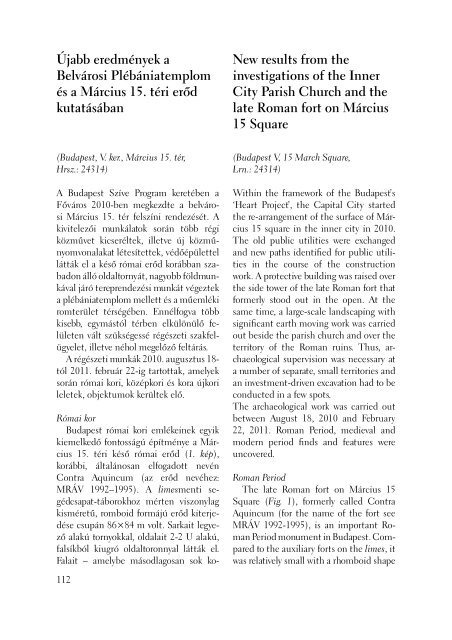
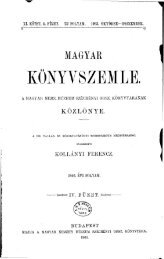
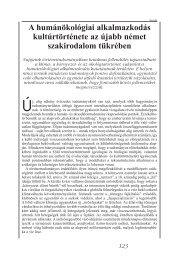
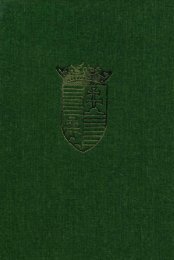
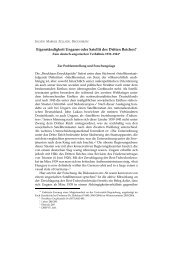
![Letöltés egy fájlban [36.8 MB - PDF] - EPA](https://img.yumpu.com/23369116/1/172x260/letoltes-egy-fajlban-368-mb-pdf-epa.jpg?quality=85)
